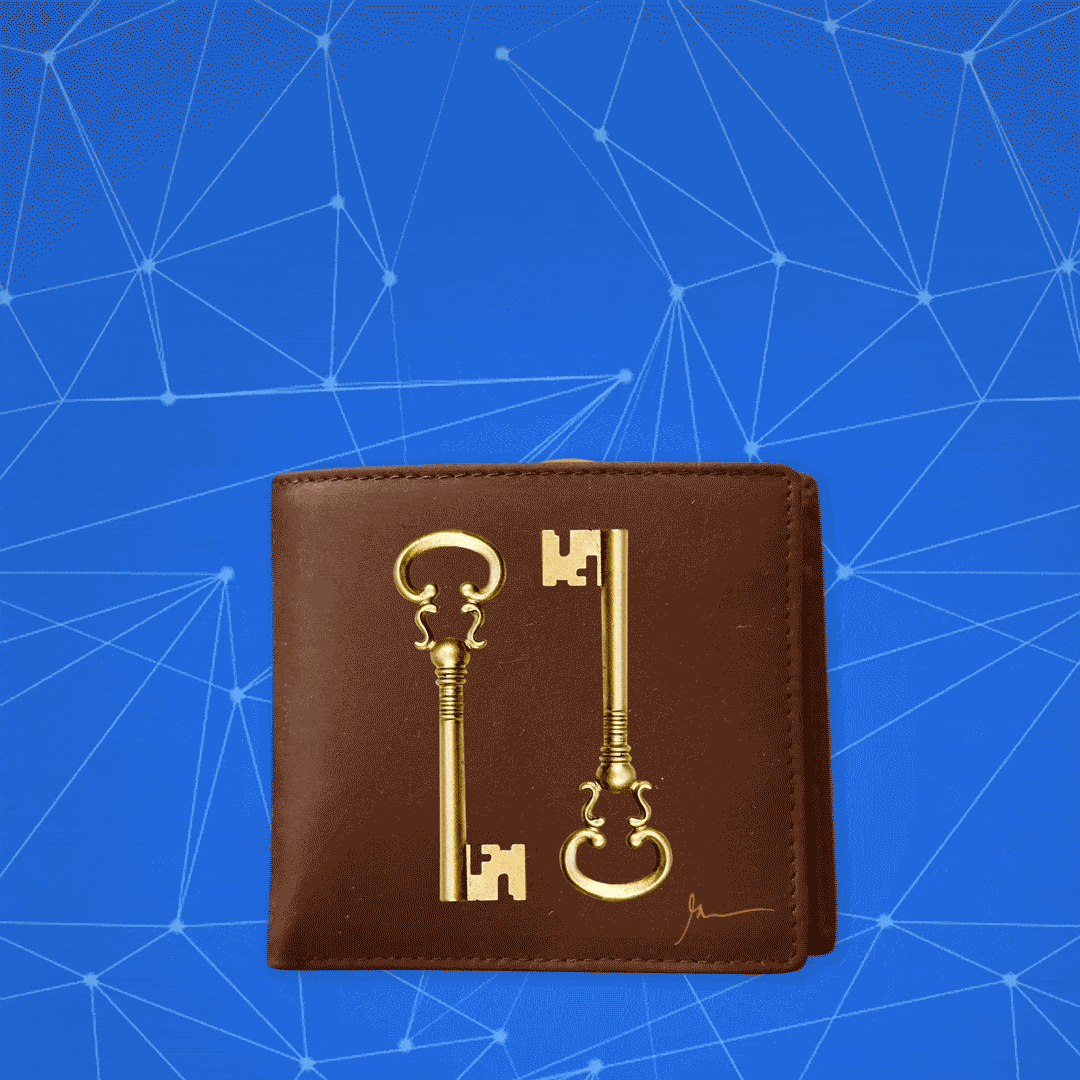Hey everybody. Before we jump into the article, I invite you all to check out my NFT project, VEEFRIENDS, which launched on Tuesday May 11th! My article, How to Buy Your First VeeFriends, will walk you through the concept behind the project as well as how to make a purchase. I also encourage you to join the Discord community – just a fun place to connect, hang out and ask your questions on all things VeeFriends. Hope to meet you there!
I wanted to write this article for two reasons:
- It’s just a good article to write as many of you navigate these uncharted crypto waters.
- I am currently working on something very cool that is going to happen in early May, and it is very important to me that my OG community is disproportionately benefitting from it.
With that said, I know that many of you have not yet created a wallet that is functional for NFT purchasing. You may have a Coinbase account at this point, but very few are actually set up to buy an NFT. Let’s fix that.
I want to say this, though, before you read the rest of this article. Many of you made fun of your parents 10 to 15 years ago when they were scared to put a credit card into a website to buy something. You ragged on them or you made jokes behind their backs…Today, you’re in the same exact position your parents were in. Many of you are now hesitant to open a MetaMask account or even a basic Coinbase account. I just want to remind you that you have become your parents — everyone’s worst nightmare 😉.
So please, use that line to inspire you to take this article seriously and set up your wallet. The NFT revolution is here and I want you to be ready. I’ve asked my content team, Team GaryVee, to help write the rest of this article in as much detail as possible, so I hope that you enjoy it.
Team GaryVee here 👋
Hello everyone, and thanks for reading and your interest in Gary’s NFT project! After a strong response to Gary’s What is NFT? article, we wanted to continue the crypto conversation with a guide on how to set up your own cryptocurrency wallet. Starting off with a general overview on wallets and how they work, we’ll then take you through the exact steps you need to take to create a wallet compatible with purchasing not just Gary’s upcoming NFT project, but any NFT that might be of interest to you. Afterward, check out 4 Steps to Make Sure You Have Ethereum in Your Wallet to be ready for Gary’s launch on 5/5! We hope our outline will provide you with the knowledge and foundation you need to make your entry into this space as safe and seamless as possible!
WHAT ARE CRYPTOCURRENCY WALLETS?
Cryptocurrency wallets are software used to communicate with blockchain networks to safely access, send and receive crypto funds or assets. Simply put, the software stores your crypto just like traditional wallets store your cash and credit cards. Where things get interesting is in the storage mechanism. Unlike fiat money — aka USD, CAD, etc. — which you store in a bank, crypto assets are stored on the blockchain. Just like you use a debit card to access your paper money at an ATM, you use your crypto wallet to access your crypto on the public ledger. The crypto wallet does not actually hold physical items — instead, it holds unique digital passwords or “private keys” which allow you to transact on the blockchain.

Crypto wallets come in the form of devices, mediums or smartphone applications and help you access records of transaction history that are held on the ledger. Simply put, if you want to actually use your crypto, you’ll need a wallet to do so.
CUSTODIAL VS. NON-CUSTODIAL
When it comes to storing your crypto, let’s talk about two options: custodial or non-custodial wallets. Check out this detailed comparison, but we will give you the breakdown here.
Custodial Wallets
Many people make their first crypto purchases on centralized exchanges. These are online marketplaces where you can buy, sell and store a variety of cryptocurrencies. Many of you may have heard of Coinbase, one of the most popular centralized exchanges in the United States and a great option for beginners! Exchanges like Coinbase are known as “custodians” because they have custody over your cryptocurrency. In other words, when you make purchases with the Coinbase app, Coinbase holds your crypto for you in its own “custodial” or “hosted” wallet. This way, Coinbase acts as a third-party with ownership of your private keys, and you are trusting the platform with the responsibility of keeping your crypto safe and secure.
Custodial wallets are a convenient gateway into the crypto world. It’s as simple as signing up for a Coinbase account with your email address, verifying your identity with a photo ID, choosing a strong password and linking your credit card or bank account to start buying. While Coinbase is great for holding small amounts of crypto and buying major cryptocurrencies such as bitcoin and Ether, the company does not yet offer NFTs — although they may soon be considering it.
For now, if you want to be able to purchase NFTs, you’ll need to have what is called a non-custodial wallet.
Non-custodial Wallets
For full control over your crypto assets, a non-custodial wallet is your best and safest bet. With these wallets, there is no third-party involved and you are the owner of your own private keys. While this is ideal for security, it also comes with great responsibility. More on the importance of private keys in just a bit. For now, let’s talk about where non-custodial wallets come into play.
Say you have a Coinbase account but you now want full control over your crypto. Good news, you can transfer your crypto holdings from Coinbase into your own non-custodial wallet! This is especially helpful for those of you looking to store large amounts of crypto, or for people looking to purchase NFTs. Since NFTs exist mostly on the Ethereum blockchain, you would need to purchase Ether on Coinbase and then transfer it to your non-custodial wallet, which you would then use to buy an NFT from online marketplaces such as NiftyGateway, OpenSea, Rarible, etc. You can also buy Ether directly using a non-custodial wallet like MetaMask! If you want to be ready for Gary’s upcoming project, MetaMask is what he recommends. Don’t worry, we’ll get you set up by the end of this article 😉

For the purposes of this article, we will be focusing specifically on non-custodial wallets, which come in several options: software (web, mobile or desktop), hardware and paper. Before we dig deeper into each category, let’s explore how wallets actually work.
HOW DO THEY WORK?
Every cryptocurrency wallet functions using public keys and private keys. These keys work in tandem to make secure and verifiable cryptocurrency transactions on a blockchain. For definitions of these and more important cryptocurrency terms, check out this guide from One37 or see this more in-depth explanation to learn more about keypairs and encryption. For now, let’s go over the basics.
Public Keys and Addresses
Wallet addresses are derived from a public and private key pair, and identify your account on the blockchain, thus allowing you to receive crypto. Think of an address like an email address — you can share it anywhere! Whoever knows your address can send you crypto. An Ethereum address will always start with 0x and then a string of 40 alphanumeric characters. It may also appear as a scannable QR code.
Private Keys & Seed Phrases
Every public key is mathematically linked to a private key in a unique key pairing. A private key — which appears as a string of alphanumeric characters — is used to digitally sign a transaction to authenticate your transactions on the blockchain. One private key can generate several wallet addresses.
Seed Phrase > Private Key > Public Key > Address
A seed phrase is a group of 12 or 24 words usually generated within the wallet software that can be used to derive your private key. Further, your private key can be used to derive your public key — however, it is important to note that your public key cannot be used to recover your private key or seed phrase. Therefore, guard your private keys and seed phrases with your life! Check out this guide on best practices for storing your seed phrase safely.
WHY YOU SHOULD ALWAYS PROTECT YOUR PRIVATE KEYS
It sounds dramatic, but we cannot stress this enough. Private keys and seed phrases must NEVER be shared with anyone or left susceptible to discovery or theft. Think of a private key like a password or better yet, a PIN number — whoever has it has access to your crypto assets. Why is this so important? Unlike traditional money, stolen crypto is lost forever. There is no bank to call and report the theft; not even the government can help you recover lost or stolen assets. For this reason, when you create a crypto wallet and receive your private key and/or seed phrase, be sure to store it offline in a secret, safe location only accessible to you. Never store your keys in online notebooks unencrypted, or type into any website.
TYPES OF CRYPTOCURRENCY WALLETS
Remember, there are a few categories of crypto wallets. Let’s explore each option.
Software Wallets – HOT storage
Software wallets are considered to be “hot storage,” a term referring to any wallet that has been directly connected to the internet. Software wallets can be further broken down into several wallet types — web, mobile and desktop.
WEB WALLETS
e.g. MetaMask Chrome extension, Mycrypto.com
Web wallets include both browser extensions and websites, and can be used on most computers with access to the internet. MetaMask browser extension is a great web option generally accepted on all web3 applications. This makes them extremely convenient, however, they are vulnerable to cyber attacks.
MOBILE WALLETS
e.g. MetaMask Mobile, Rainbow, Argent
Mobile wallets are accessed via smartphone apps. As they are easily downloadable right to your phone or mobile-device, these wallets are great for everyday, on-the-go access and purchases. Just like your computer, you should always keep your phone updated and protected.
DESKTOP WALLETS
e.g. Mycrypto client-side
Desktop wallets are software programs downloaded and installed directly onto your PC or laptop. Private keys are input into this software and never leave the original machine onto which they were downloaded.
While convenient, software or hot wallets are best used only for storing smaller amounts of crypto due to the risk of hackers or viruses.
COLD storage
On the flip side, “cold storage” wallets store your keys independently of an internet connection, providing higher security and protection.
HARDWARE WALLETS
e.g. Ledger, Trezor
One of the most secure options, hardware wallets are physical devices you can buy that allow you to make transactions without exposing your seed phrase or private keys to the internet. Hardware wallets typically look like a USB or thumb drive which you connect to your computer or laptop when making a transaction, and then remove once finished. Since your private keys are stored on the device itself and not on a computer or online platform, hardware wallets are very hard to exploit.
PAPER WALLETS
Paper wallets are really just a way to store the private key and public key pair for your account on a piece of paper. They can be a way to store crypto keys you don’t plan to access for a long time, but are generally deemed obsolete in lieu of seed phrases.
WHERE TO GET A CRYPTOCURRENCY WALLET
Depending on your specific needs, you can download your crypto wallet to your computer (desktop) or phone (mobile), create it on a web browser (web), buy it from a store (hardware) or print it out (paper). Where you go to get your crypto wallet depends on need and personal preference. Great options include the Rainbow mobile wallet, Ledger or Trezor for hardware or one of our favorites as a browser extension — MetaMask!
MetaMask is an Ethereum wallet available for both web and mobile, and in our opinion, it’s one of the best crypto wallet options on the market and perfect for anyone interested in buying an NFT. Since its launch in 2016, MetaMask has gathered over one million monthly active users and is proving to be a popular, trusted option among Gary’s community:


Want to learn more? Visit the MetaMask FAQ Support page.
HOW TO SET UP A METAMASK WALLET ON DESKTOP
Here is how to create a MetaMask desktop wallet via a Chrome extension. You can also use other browsers such as Firefox and Brave. Whatever you choose, it is very important that you only download from the official MetaMask site.
- Go to MetaMask.io
- Click either of the “Download” buttons on the homepage.
- Click “Install MetaMask for Chrome.” You will be automatically taken to the Google Chrome web store.
- Click “Add to Chrome” and add the extension. Once installed, you will be able to view the MetaMask fox head icon in the top right corner of your browser by clicking on the puzzle piece icon.
- Click “Get Started” and choose between importing an existing wallet or setting up a new one. Let’s assume you don’t have an existing wallet and need to create one. Click “Create a Wallet.”
- Create and confirm a password according to MetaMask’s guideline of 8 characters minimum. Make sure your password is unique and not being used for anything else. Agree to the terms of use and hit “Create.” Congratulations! You are now the owner of a MetaMask wallet! 🎉
- Once you’ve created your wallet, you will be able to view your seed phrase (the 12 word sequence used to recover and backup your wallet). Remember, this must be hidden and never shared with anyone. Do not take a picture or screenshot of your seed phrase — instead, write it down immediately on a piece of paper and put it in a secret, safe location. Even better, write your seed phrase down on 2-3 pieces of paper and store each paper in a separate secure location (like one in a personal safe and one in a bank safety deposit box). Alternatively, you can download the seed phrase and keep it offline on an encrypted hard drive. Having multiple backups of your seed phrase is good practice just in case one copy is ever lost or destroyed. After documenting your seed phrase, click “Next.”
- Confirm your seed phrase by clicking on the correct words in the correct order of your 12 word sequence and click “Confirm.”
- Click “All Done.”
- Optional – you can leave your new account as “account 1” or choose to rename it.
It’s that easy! You can now access your MetaMask wallet via the fox icon in your browser and begin purchasing and receiving crypto! If you already have Ether in your Coinbase, you can use your brand new Ethereum address (the long number at the top of your wallet page starting with 0x…) to transfer them over into your MetaMask wallet. If you don’t have a Coinbase account, you can buy Ether directly through MetaMask in some U.S. states, however, Coinbase is our favorite way to get Ether into your MetaMask wallet at the moment.
HOW TO SET UP A METAMASK WALLET ON MOBILE
MetaMask also offers a mobile wallet option for both ios and Android. Here are the steps to use MetaMask on your phone if you’ve already set up the desktop extension:
- Download the MetaMask app to your smartphone (App Store for iPhone or Google Play Store for Android).
- Click “Get Started”
- Click “Sync with MetaMask extension”
- Open your MetaMask desktop extension, go to Settings > Advanced, Click on “Sync with Mobile” and enter your password.
- Using your phone’s camera, scan the QR code to start syncing.
Now you will be able to access your MetaMask account from either your desktop or your phone! If you do not have the desktop extension and wish to create your first MetaMask account on mobile, follow the same steps above, but click “Create a new wallet” instead of “Sync with MetaMask extension.” Then, follow the rest of the prompts to choose your password and see and confirm your seed phrase.
If you prefer to keep your crypto in cold storage, you can easily connect a hardware wallet like Ledger or Trezor to MetaMask. This gives you the security of a hardware wallet with the ability to connect with any MetaMask/web3 enabled sites.
🚨 IMPORTANT NOTE! 🚨
We know that many of you are itching to get started in the NFT world! Be aware that if you want to make an NFT purchase, you need to be set up about a week in advance!
When you initiate a purchase on Coinbase, the platform uses what is called an ACH bank transfer system for payments with your bank account. This means that Coinbase will take **minimally 5 days to actually complete your transaction and make your Ether available in your account. Therefore, if you’re interested in transferring Ether purchased on Coinbase into your MetaMask, we highly recommend you get set up NOW so you won’t experience any delays.
Better yet, you may want to avoid the ACH transfer delays altogether, with the option to wire money from your bank into your Coinbase wallet. Defer to your bank for their specific wire transferring process if you choose to expedite your deposits using a wire transfer.
Trust us, come early May, you’ll want to be ready to go! PS: Please make sure you have AT LEAST 1 ETH in your wallet for the project!
THE BOTTOM LINE
By now, we hope you have a much more comfortable understanding of how cryptocurrency wallets work and the different options available to you. Remember, safety first! Whichever wallet you choose, always protect your private keys and be mindful of the people with whom you transact.
If you found value in this article, we would love it if you shared with any of your friends who have been asking about purchasing an NFT or setting up their own cryptocurrency wallet.












yok cek cek gesss kali aja demen
temanslot dan situs slot777 cocok buat pemula maupun yang udah pro.
At first, I was skeptical about trying Mega888, but it turned out to be really fun and rewarding. I even hit a decent win last week! If you’re into online slots, you should give it a shot – just remember to play responsibly.
What I really like about kudustoto is how beginner-friendly it is. Even if you’ve never played before, the site is easy to navigate and the support team is always ready to help.
Профессиональный сервисный центр по ремонту бытовой техники с выездом на дом.
Мы предлагаем:сервисные центры по ремонту техники в мск
Наши мастера оперативно устранят неисправности вашего устройства в сервисе или с выездом на дом!
I was recently scammed out of $53,000 by a fraudulent Bitcoin investment scheme, which added significant stress to my already difficult health issues, as I was also facing cancer surgery expenses. Desperate to recover my funds, I spent hours researching and consulting other victims, which led me to discover the excellent reputation of Capital Crypto Recover, I came across a Google post It was only after spending many hours researching and asking other victims for advice that I discovered Capital Crypto Recovery’s stellar reputation. I decided to contact them because of their successful recovery record and encouraging client testimonials. I had no idea that this would be the pivotal moment in my fight against cryptocurrency theft. Thanks to their expert team, I was able to recover my lost cryptocurrency back. The process was intricate, but Capital Crypto Recovery’s commitment to utilizing the latest technology ensured a successful outcome. I highly recommend their services to anyone who has fallen victim to cryptocurrency fraud. For assistance, contact Recovercapital @ cyberservices. com Capital Crypto Recover on Telegram OR Call Number +1 (336)390-6684
Absolutely loved this! Keep up the amazing work!
There’s a deep serenity in your words that makes this space feel sacred.
If I could describe your blog in one word, it would be “extraordinary.” But even that feels like an understatement.
Your thoughts are like lanterns, quietly illuminating important corners of the mind.
How To Recover Your Bitcoin Without Falling Victim To Scams: A Testimony Experience With Capital Crypto Recover Services, Contact Telegram: @Capitalcryptorecover
Dear Everyone,
I would like to take a moment to share my positive experience with Capital Crypto Recover Services. Initially, I was unsure if it would be possible to recover my stolen bitcoins. However, with their expertise and professionalism, I was able to fully recover my funds. Unfortunately, many individuals fall victim to scams in the cryptocurrency space, especially those involving fraudulent investment platforms. However, I advise caution, as not all recovery services are legitimate. I personally lost $273,000 worth of Bitcoin from my Binance account due to a deceptive platform. If you have suffered a similar loss, you may be considering crypto recovery, The Capital Crypto Recover is the most knowledgeable and effective Capital Crypto Recovery Services assisted me in recovering my stolen funds within 24 hours, after getting access to my wallet. Their service was not only prompt but also highly professional and effective, and many recovery services may not be trustworthy. Therefore, I highly recommend Capital Crypto Recover to you. i do always research and see reviews about their service, For assistance finding your misplaced cryptocurrency, get in touch with them, They do their jobs quickly and excellently, Stay safe and vigilant in the crypto world.
You can reach them via email at Capitalcryptorecover @ zohomail. com OR Call/Text Number +1 (336)390-6684 his contact: Recovercapital @cyberservices. com
I would like to take a moment to share my positive experience with Capital Crypto Recover Services. Initially, I was unsure if it would be possible to recover my stolen bitcoins.
What you create here is more than content—it’s a genuine connection with your readers.
Absolutely loved this! Keep up the amazing working dude!
Your words have a quiet strength that resonates long after reading.
HOW I RECOVER MY $275,000 FROM CRYPTO SCAMMER USA.
I’m one of the fortunate individuals who ventured into the cryptocurrency market with hopes of building a nest egg for retirement. Sadly, I invested in a fraudulent platform that ended up scamming me out of approximately $275,000, not including the promised profits. I lost everything, including funds borrowed from friends in my investment quest. Just when I thought all was lost, I discovered the cryptocurrency recovery experts at JetWebHackers. They successfully helped me recover my funds within 72 hours, and I was even able to track down the scammers. I am incredibly thankful for their assistance and strongly recommend their services to anyone facing a similar situation.
Reach out to them today and turn your situation around!
WEBSITE: jetwebhackers. com
EMAIL: jetwebhackers@gmail.com
Telegram: @jetwebhackers
WhatsApp: +1 (325) 721-3656
There’s a kindness in your voice that radiates through every sentence. Reading your posts feels like receiving a warm, gentle embrace.